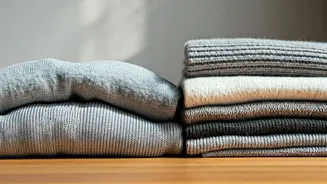Gentle Washing Techniques
The initial step to revitalizing your woollens involves proper washing techniques. Start by inspecting the care label on each garment; it dictates the appropriate
washing method. For delicate woollens, hand washing is frequently the safest option. Use lukewarm water and a mild detergent specifically designed for wool. Submerge the item, gently agitating the water with your hands. Avoid harsh scrubbing or twisting, which can damage the fibers. Rinse thoroughly with clean, lukewarm water until all traces of soap are gone. Gently squeeze out excess water, being careful not to wring the garment. If your item is machine-washable, opt for a delicate cycle with cold water. Place the woollen item in a mesh laundry bag to prevent snagging and reduce friction, which can lead to pilling. Always use a detergent formulated for wool to safeguard the fabric's integrity. Remember, gentle handling during washing is crucial for preserving the quality and longevity of your woollens.
Air Drying Essentials
Proper drying is as crucial as washing when it comes to maintaining the condition of your woollen clothes. The ideal approach is to air dry them. After washing, carefully reshape the garment to its original form. Lay it flat on a clean, dry surface, such as a drying rack or a fresh towel. Avoid hanging woollens, as the weight of the water can cause them to stretch and lose their shape. Ensure the area has good air circulation to promote faster drying. Direct sunlight and heat are not wool's friends; they can cause fading and shrinkage. Place the garment away from any direct heat sources. If you're short on space, consider using a clothesline, but always ensure the garment is supported correctly to prevent stretching. Rotate the garment occasionally to ensure even drying. Air drying preserves the fibres, prevents damage, and helps your woollens maintain their shape, ensuring they look great and last longer.
Vinegar's Odor-Removing Power
Vinegar, a household staple, acts as a natural deodorizer and can effectively eliminate stubborn odors from your woollens. The process is simple: add one cup of white vinegar to your wash cycle during the rinse phase. The vinegar's acidity neutralizes odor-causing bacteria, leaving your clothes smelling fresh. Vinegar also helps to soften the fabric and remove any lingering soap residue, which can contribute to odors. For particularly pungent smells, consider soaking the woollen item in a solution of cold water and vinegar for about 30 minutes before washing. Ensure to rinse thoroughly afterward to remove all traces of vinegar. Vinegar is safe for most woollens, but always test on a hidden area first to ensure there's no color bleeding or damage. By using vinegar, you can naturally refresh your woollens without resorting to harsh chemicals.
Lint Removal Techniques
Lint, those tiny fuzzy balls, can make your favourite woollens look less than perfect. Thankfully, removing them is a straightforward process. A lint roller is your first line of defense; use it to gently roll over the surface of your garment to pick up loose fibres and lint. For more stubborn lint, a fabric shaver is an excellent tool. This device carefully trims away pills and lint without damaging the fabric. Always use a light touch to avoid cutting holes. Place the garment on a flat surface and carefully run the shaver over the affected areas. A fine-toothed comb can also be useful for removing lint. Gently comb the fabric in one direction to lift and remove the lint balls. A pumice stone for clothes, though less commonly used, can also be effective but use it with extreme care, as it can be abrasive. Regular lint removal extends the life of your woollens, keeping them looking smooth and presentable.
Storage Savvy Tips
Proper storage is essential to preserving your woollens' condition and preventing odor absorption and lint buildup. Before storing your woollen items, ensure they are clean, dry, and free of any odors or lint. Place them in a breathable storage container, such as a cotton storage bag or a container with good ventilation. Avoid storing them in plastic bags, as they can trap moisture and promote mildew growth. Cedarwood or lavender sachets can be added to your storage space to repel moths and absorb moisture, which also helps to keep your clothes smelling fresh. Keep your woollens away from direct sunlight and areas with extreme temperature fluctuations. Fold your garments neatly to prevent stretching and wrinkling. Consider using acid-free tissue paper between layers to prevent friction and maintain their shape. Proper storage extends the life of your woollens and ensures they are ready to wear whenever you need them, without unpleasant surprises.












